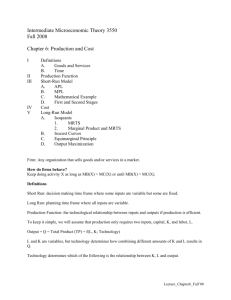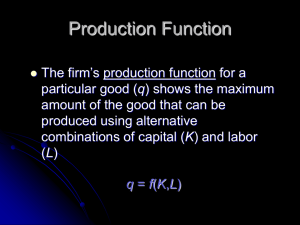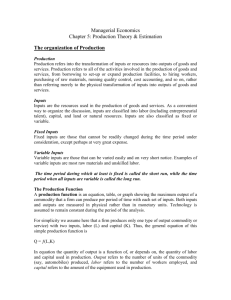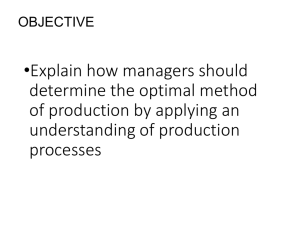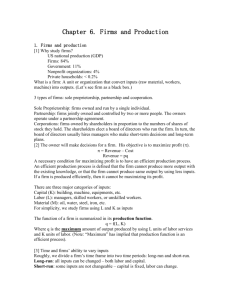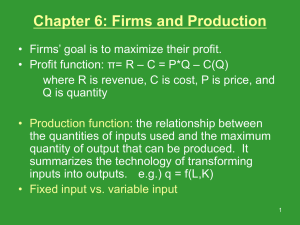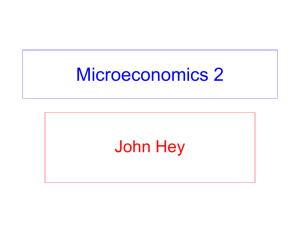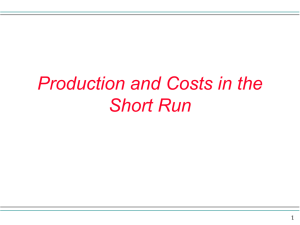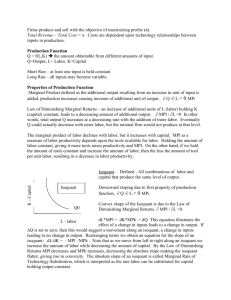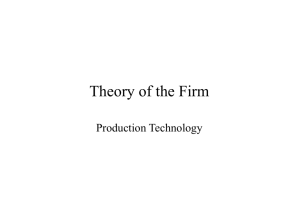managerial economics - WW Norton & Company
advertisement
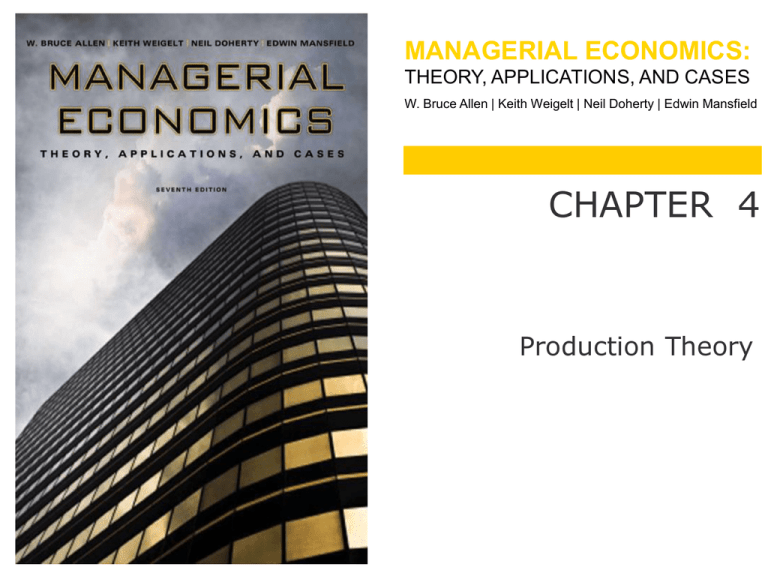
MANAGERIAL ECONOMICS: THEORY, APPLICATIONS, AND CASES W. Bruce Allen | Keith Weigelt | Neil Doherty | Edwin Mansfield CHAPTER 4 Production Theory OBJECTIVES • Explain how managers should determine the optimal method of production by applying an understanding of production processes • Understand the linkages between production processes and costs PRODUCTION PROCESSES • Production processes include all activities associated with providing goods and services, including • Employment practices • Acquisition of capital resources • Product distribution • Managing intellectual resources PRODUCTION PROCESSES • Production processes define the relationships between resources used and goods and services produced per time period. • Managers exert control over production costs by understanding and managing production technology. PRODUCTION FUNCTION WITH ONE VARIABLE INPUT • A production function shows the maximum amount that can be produced per time period with the best available technology from any given combination of inputs. • Table • Graph • Equation PRODUCTION FUNCTION WITH ONE VARIABLE INPUT • Production Function Example • Q = f(X1, X2) • Q = Output rate • X1 = Input 1 usage rate • X2 = Input 2 usage rate • Q = 30L + 20L2 – L3 • Q = Hundreds of parts produced per year • L = Number of machinists hired • Fixed Capital = Five machine tools PRODUCTION FUNCTION WITH ONE VARIABLE INPUT • Unit Functions • Average Product of Labor = APL = Q/L • Common measuring device for estimating the units of output, on average, per worker PRODUCTION FUNCTION WITH ONE VARIABLE INPUT • Unit Functions (Continued) • Marginal Product of Labor = MPL = Q/L • Metric for estimating the efficiency of each input in which the input’s MP is equal to the incremental change in output created by a small increase in the input • Using calculus (assumes that labor can be varied continuously): MP = dQ/dL PRODUCTION FUNCTION WITH ONE VARIABLE INPUT • Unit Functions (Continued) • Unit function examples from Q = 30L + 20L2 – L3 • Table 4.2 and Figure 4.2 • APL = 30 + 20L – L2 • Using calculus: MPL = 30 + 40L – 3L2 • APL is at a maximum, and MPL = APL, at L = 10 and MPL = APL = 130 • MPL is at a maximum at L = 6.67 and MPL = 163.33 PRODUCTION FUNCTION WITH ONE VARIABLE INPUT • Unit Functions (Continued) • Why does MPL = APL when APL is at a maximum? • If MPL > APL, then APL must be increasing • If MPL < APL, then APL must be decreasing THE LAW OF DIMINISHING MARGINAL RETURNS • Law of diminishing returns • When managers add equal increments of an input while holding other input levels constant, the incremental gains to output eventually get smaller THE PRODUCTIONN FUNCTION WITH TWO VARIABLE INPUTS • Q = f(X1, X2) • Q = Output rate • X1 = Input 1 usage rate • X2 = Input 2 usage rate • AP1 = Q/X1 and MP1 = Q/X1 or dQ/dX1 • AP2 = Q/X2 and MP2 = Q/X2 or dQ/dX2 • Example • Table 4.3 and Figure 4.3 ISOQUANTS • Isoquant: Curve showing all possible (efficient) input bundles capable of producing a given output level. • Graphically constructed by cutting horizontally through the production surface at a given output level • Isoquants representing different output levels are shown in Figure 4.4. ISOQUANTS • Properties • Isoquants farther from the origin represent higher input and output levels. • Given a continuous production function, every possible input bundle is on an isoquant and there is an infinite number of possible input combinations. • Isoquants slope downward to the left and are convex to the origin. MARGINAL RATE OF TECHNICAL SUBSTITUTION • Marginal rate of technical substitution (MRTS): Shows the rate at which one input is substituted for another (with output remaining constant) • Q = f(X1, X2) • MRTS = –X2/X1 with Q held constant and X2 on the vertical axis • MRTS = MP1/MP2 • MRTS = Absolute value of the slope of an isoquant MARGINAL RATE OF TECHNICAL SUBSTITUTION • MRTS and isoquants (with X2 on the vertical axis) • If the MRTS is large, it takes a lot of X2 to substitute for one unit of X1, and isoquants will be steep. • If the MRTS is small, it takes little X2 to substitute for one unit of X1, and isoquants will be flat. MARGINAL RATE OF TECHNICAL SUBSTITUTION • MRTS and isoquants (with X2 on the vertical axis) (Continued) • If X1 and X2 are perfect substitutes, MRTS is constant, and isoquants will be straight lines. • If X1 and X2 are perfect complements, no substitution is possible, MRTS is undefined, and isoquants will be right angles. MARGINAL RATE OF TECHNICAL SUBSTITUTION • Ridge Lines • Ridge lines: The lines that profit-maximizing firms operate within, because outside of them, marginal products of inputs are negative • Economic region of production is located within the ridge lines. THE OPTIMAL COMBINATION OF INPUTS • Isocost curve: Curve showing all the input bundles that can be purchased at a specified cost • PLL + PKK = M • L = Labor use rate • PL = Price of labor • K = Capital use rate • PK = Price of capital • M = Total outlay THE OPTIMAL COMBINATION OF INPUTS • Isocost curve (Continued) • K = M/PK – (PL/PK)L • Vertical intercept = M/PK • Horizontal intercept = M/PL • Slope = – PL/PK THE OPTIMAL COMBINATION OF INPUTS • Optimal Combination of Inputs • Tangency between isocost and isoquant • MRTS = MPL/MPK = PL/PK • MPL/PL = MPK/PK • Marginal product per dollar spent should be the same for all inputs. • MPa/Pa = MPb/Pb = = MPn/Pn • Maximize output for given cost: Figure 4.8 • Minimize cost for a given output: Figure 4.9 CORNER SOLUTIONS • Optimal input combination does not occur at a point of tangency between isocost and isoquant curves. • In a two-input case, one of the inputs will not be used at all in production. • Example: Figure 4.10 CORNER SOLUTIONS • If two inputs are perfect complements (isoquants are right angles), then both inputs will be used, but the optimal combination will not occur at a point of tangency between isocost and isoquant curves. RETURNS TO SCALE • Long-run effect of an equal proportional increase in all inputs • Increasing returns to scale: When output increases by a larger proportion than inputs • Decreasing returns to scale: When output increases by a smaller proportion than inputs • Constant returns to scale: When output increases by the same proportion as inputs RETURNS TO SCALE • Sources of increasing returns to scale • Indivisibilities: Some technologies can only be implemented at a large scale of production. • Subdivision of tasks: Larger scale allows increased division of tasks and increases specialization. RETURNS TO SCALE • Sources of increasing returns to scale (Continued) • Probabilistic efficiencies: Law of large numbers may reduce risk as scale increases. • Geometric relationships: Doubling the size of a box from 1 X 1 X 1 to 2 X 2 X 2 multiplies the surface area by four times (from 3 to 12) but increases the volume by eight times (from 1 to 8). This applies to storage devices, transportation devices, etc. RETURNS TO SCALE • Sources of decreasing returns to scale • Coordination inefficiencies: Larger organizations are more difficult to manage. • Incentive problems: Designing efficient compensation systems in large organizations is difficult. THE OUTPUT ELASTICITY • Output elasticity: The percentage change in output resulting from a 1 percent increase in all inputs. • Note: A more common definition of output elasticity is the percentage change in output resulting from a 1 percent increase in a single input. Accordingly, the coefficients 0.3 and 0.8 in the Cobb-Douglas function below would be referred to as the output elasticities of labor and capital, respectively. THE OUTPUT ELASTICITY • Cobb-Douglas production function example: Q = 0.8L0.3K0.8 • Q = Parts produced by the Lone Star Company per year • L = Number of workers • K = Amount of capital • Output elasticity = 1.1 for infinitesimal changes in inputs • Example calculation for 1 percent increase in both inputs • Q' = 0.8(1.01L)0.3(1.01K)0.8 = 1.011005484Q ESTIMATIONS OF PRODUCTION FUNCTIONS • Cobb-Douglas Mathematical form: = aLbKc Q • MPL = Q/L = b(Q/L) = b(APL) • Linear estimation: log Q = log a + b log L + c log K • Returns to scale • b + c > 1 => increasing returns • b + c = 1 => constant returns • b + c < 1 => decreasing returns This concludes the Lecture PowerPoint presentation for Chapter 4 Visit the StudySpace at: http://www.wwnorton.com/college/econ/mec7/ © 2009 W. W. Norton & Company, Inc.
